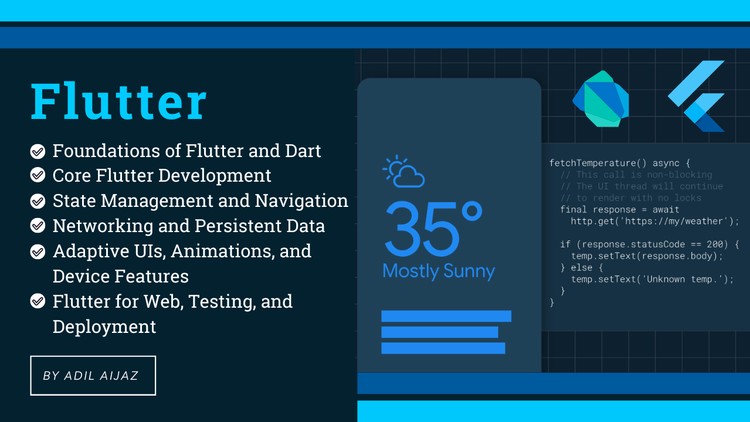
Complete Flutter Improvement Apply Check: Check Your Information with Apply Questions
What you’ll study
Fundamental syntax, management buildings, and object-oriented programming ideas.
Establishing the event surroundings and understanding the Flutter framework.
Distinction between Stateless and Stateful widgets, and constructing UIs utilizing numerous structure widgets.
Managing app state utilizing setState, Supplier, and extra superior strategies like Riverpod or Bloc.
Implementing navigation between screens, together with passing knowledge and utilizing named routes.
Fetching knowledge from APIs, dealing with JSON, and dealing with native databases (SQLite) and Firebase.
Creating adaptive UIs that work properly on completely different gadgets and display sizes.
Including animations to enhance consumer expertise, each easy and superior, together with Hero animations.
Accessing native options just like the digital camera, geolocation, and implementing push notifications.
Writing unit, widget, and integration exams, and utilizing debugging instruments to enhance app efficiency.
Getting ready apps for launch, together with signing and deploying them to the App Retailer and Play Retailer.
Understanding the variations when constructing for the online and adapting apps accordingly.
Why take this course?
Part 1: Foundations of Flutter and Dart
This part introduces the essential constructing blocks of Flutter and Dart, serving to you identify a stable basis earlier than transferring on to extra complicated matters.
- Dart Fundamentals: On this matter, you’ll discover Dart’s syntax, management buildings like loops and conditionals, and object-oriented programming (OOP) ideas. Understanding these fundamentals is crucial for writing efficient Flutter functions, as Dart is the core language utilized in Flutter improvement.
- Flutter Introduction and Setup: Right here, you’ll study what Flutter is and easy methods to arrange your improvement surroundings. The questions will concentrate on understanding Flutter’s core options, equivalent to the new reload function, and the steps required to put in Flutter and configure your IDE.
- Fundamental Widgets and Layouts: Widgets are the center of any Flutter app. You’ll work with widespread widgets like Textual content, Container, Row, and Column, studying easy methods to construction your app’s UI. This matter is crucial for constructing even the best apps, so understanding easy methods to use these widgets successfully is essential.
- Writing Your First App: On this matter, you’ll concentrate on creating your first Flutter app, sometimes a “Hiya World” instance. This offers you hands-on expertise with establishing a venture, writing code, and seeing how widgets come collectively to kind a purposeful app.
Part 2: Core Flutter Improvement
This part dives into the elemental facets of Flutter improvement. You’ll cowl the core parts that each Flutter app depends on, from constructing UIs to dealing with consumer enter.
- Stateless vs Stateful Widgets: One of the essential distinctions in Flutter is between stateless and stateful widgets. You’ll discover the variations, easy methods to implement each, and when to make use of every sort of widget. Understanding that is essential for managing the habits of your app and controlling its UI updates.
- Layouts and Flexbox: Creating responsive layouts is a core ability in Flutter improvement. You’ll concentrate on utilizing widgets like Row, Column, and Flex to construct layouts that regulate dynamically to completely different display sizes. You’ll additionally work with instruments like Expanded and Versatile for higher management over house distribution.
- Dealing with Person Enter: Apps have to work together with customers, and dealing with enter is vital. You’ll work with widgets like TextField and Button to seize and validate consumer enter, studying easy methods to handle kind knowledge and use built-in validation instruments to make sure knowledge integrity.
- Gesture Detection: This matter covers how Flutter responds to consumer gestures like faucets, swipes, and lengthy presses. You’ll discover GestureDetector and different widgets that enable your app to react to consumer interactions in real-time.
- Widget Tree Construction: Understanding the widget tree is essential for constructing complicated Flutter apps. You’ll concentrate on how widgets are organized hierarchically and the way parent-child relationships have an effect on the app’s structure and habits. This information helps you construct apps that aren’t solely purposeful but additionally scalable.
Part 3: State Administration and Navigation
State administration is without doubt one of the most difficult but important ideas in Flutter. This part focuses on easy methods to handle app state successfully and navigate between screens.
- State Administration Fundamentals (setState, Native State): Right here, you’ll learn to replace your app’s UI by managing native state with setState. This elementary idea permits you to change the looks of your app based mostly on consumer interplay or knowledge modifications.
- Supplier for State Administration: Supplier is a well-liked bundle for managing state effectively throughout your app. You’ll dive into the way it works, specializing in easy methods to arrange suppliers, hearken to modifications, and replace the UI based mostly on world state modifications.
- Superior State Administration (Riverpod, Bloc): In additional complicated apps, chances are you’ll want extra superior state administration options like Riverpod or Bloc. This matter explores these alternate options, serving to you perceive when and why to make use of them over less complicated options like Supplier.
- Navigation Fundamentals (push, pop): Navigating between completely different screens is a core function of any cell app. You’ll learn to use Navigator.push and Navigator.pop to maneuver between routes and handle navigation stacks successfully.
- Passing Information and Named Routes: Extra complicated apps usually require passing knowledge between screens and utilizing named routes for cleaner code. You’ll observe establishing named routes and passing knowledge to make sure that your app’s navigation move is clean and environment friendly.
Part 4: Networking and Persistent Information
Fetching knowledge from the web and saving it regionally is a vital function in most apps. This part covers networking, asynchronous programming, and knowledge persistence.
- Networking (Fetching Information, JSON Dealing with): You’ll discover easy methods to make HTTP requests, fetch knowledge from APIs, and parse JSON in Flutter. That is very important for constructing apps that work together with exterior providers, equivalent to fetching climate knowledge or loading content material from a distant server.
- Async Programming (Future, async/await): Working with asynchronous code is crucial in Flutter, particularly when coping with community requests or time-consuming operations. You’ll learn to deal with async programming utilizing Future, async, and await, guaranteeing your app stays responsive throughout lengthy operations.
- SQLite Database: This matter focuses on utilizing SQLite for native knowledge storage. You’ll observe performing CRUD (Create, Learn, Replace, Delete) operations on a neighborhood database, permitting your app to retailer and retrieve knowledge even with out an web connection.
- Firebase Integration (Authentication and Firestore): Firebase is a strong backend service utilized in many cell apps. You’ll discover easy methods to combine Firebase authentication and Firestore database into your app, permitting for consumer login and cloud-based knowledge storage.
- Pagination and Infinite Scroll: Dealing with massive datasets effectively is a problem in cell improvement. You’ll learn to implement pagination and infinite scroll, permitting your app to load knowledge dynamically as customers scroll by means of lengthy lists.
Part 5: Adaptive UIs, Animations, and Machine Options
This part focuses on constructing apps that adapt to completely different gadgets and display sizes, making them extra participating by means of animations and leveraging native gadget options.
- Responsiveness (MediaQuery, LayoutBuilder): You’ll learn to create responsive UIs that regulate based mostly on the gadget’s display dimension and orientation. Instruments like MediaQuery and LayoutBuilder assist you to make apps that look nice on each cell phones and tablets.
- Themes and Customized Styling: Constant styling is vital to professional-looking apps. You’ll discover easy methods to implement world themes and customized kinds throughout your app, together with managing darkish mode and setting default fonts and colours.
- Implicit Animations (AnimatedContainer, AnimatedOpacity): Including animations could make your app really feel extra polished and fascinating. You’ll work with implicit animations like AnimatedContainer and AnimatedOpacity so as to add clean transitions without having complicated code.
- Specific Animations (AnimationController, Tween): For extra management over animations, you’ll discover express animations. This matter covers utilizing AnimationController and Tween to create extra superior, customized animations in your app.
- Hero Animations: Hero animations present seamless transitions between screens by animating shared parts. You’ll observe implementing Hero animations to create clean, visually interesting transitions between pages.
- Utilizing Machine Options (Digicam, Geolocation): Flutter permits you to entry native gadget options just like the digital camera and geolocation providers. You’ll learn to combine these options into your app, making it extra purposeful and interactive.
- Push Notifications (FCM): Push notifications are a strong software for participating customers. You’ll discover easy methods to arrange Firebase Cloud Messaging (FCM) to ship push notifications to your app, maintaining customers knowledgeable even when the app just isn’t working.
Part 6: Flutter for Internet, Testing, and Deployment
On this closing part, you’ll concentrate on increasing your Flutter expertise to internet improvement, testing your app, and making ready it for deployment.
- Flutter for Internet Overview and Adaptation: Flutter isn’t just for cell apps; it’s additionally able to constructing internet functions. You’ll discover the variations between internet and cell improvement in Flutter and easy methods to adapt your code to work seamlessly on the net.
- Unit and Widget Testing: Testing is essential for sustaining high-quality code. You’ll observe writing unit and widget exams utilizing the flutter_test bundle, guaranteeing your app behaves as anticipated and lowering bugs earlier than deployment.
- Integration Testing: Integration exams simulate consumer interactions to make sure that your app works as meant in real-world eventualities. You’ll learn to write integration exams to automate the testing of complicated workflows in your app.
- Debugging and DevTools: Debugging is a key ability for any developer. You’ll discover Flutter’s DevTools suite, studying easy methods to examine widgets, analyze efficiency, and determine points in your code.
- Getting ready Apps for Launch: On this matter, you’ll cowl the ultimate steps of app improvement — making ready your app for launch. This consists of signing APKs, optimizing your app’s efficiency, and deploying it to the App Retailer and Play Retailer.
The put up Complete Flutter Improvement Apply Check: Grasp Apps appeared first on destinforeverything.com/cms.
Please Wait 10 Sec After Clicking the "Enroll For Free" button.








